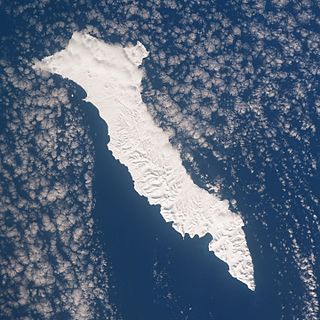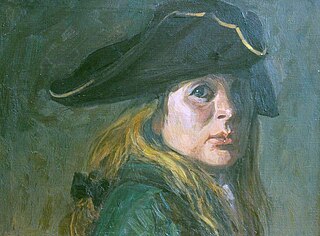
Vitus Jonassen Bering, also known as Ivan Ivanovich Bering, was a Danish-born Russian cartographer and explorer, and an officer in the Russian Navy. He is known as a leader of two Russian expeditions, namely the First Kamchatka Expedition and the Great Northern Expedition, exploring the north-eastern coast of the Asian continent and from there the western coast on the North American continent. The Bering Strait, the Bering Sea, Bering Island, the Bering Glacier, and Vitus Lake were all named in his honor.

Steller's sea cow is an extinct sirenian described by Georg Wilhelm Steller in 1741. At that time, it was found only around the Commander Islands in the Bering Sea between Alaska and Russia; its range extended across the North Pacific during the Pleistocene epoch, and likely contracted to such an extreme degree due to the glacial cycle. It is possible indigenous populations interacted with the animal before Europeans. Steller first encountered it on Vitus Bering's Great Northern Expedition when the crew became shipwrecked on Bering Island. Much of what is known about its behavior comes from Steller's observations on the island, documented in his posthumous publication On the Beasts of the Sea. Within 27 years of its discovery by Europeans, the slow-moving and easily-caught mammal was hunted into extinction for its meat, fat, and hide.

Bering Island is located off the Kamchatka Peninsula in the Bering Sea.

Georg Wilhelm Steller was a German-born naturalist and explorer who contributed to the fields of biology, zoology, and ethnography. He participated in the Great Northern Expedition (1733–1743) and his observations of the natural world helped the exploration and documentation of the flora and fauna of the North Pacific region.
The year 1836 in science and technology involved some significant events, listed below.
The year 1834 in science and technology involved some significant events, listed below.
The year 1744 in science and technology involved some significant events.
The year 1746 in science and technology involved some significant events.
The year 1853 in science and technology involved some significant events, listed below.
The year 1786 in science and technology involved some significant events.
The year 1780 in science and technology involved some significant events.
The year 1742 in science and technology involved some significant events.
The year 1709 in science and technology involved some significant events.

The Commander Islands, Komandorski Islands, or Komandorskie Islands are a series of islands in the Russian Far East, a part of the Aleutian Islands, located about 175 km (109 mi) east of the Kamchatka Peninsula in the Bering Sea. Treeless and sparsely populated, the islands consist of Bering Island, Medny Island and fifteen islets and rocks. The largest of the latter are Tufted Puffin Rock (Kamen Toporkov or Ostrov Toporkov), 15 ha, and Kamen Ariy, which are between 3 km (1.9 mi) and 13 km (8.1 mi) west of the only settlement, Nikolskoye. Administratively, the Commanders compose the Aleutsky District of the Kamchatka Krai in Russia.

Steller Secondary School is an alternative school located in Anchorage, Alaska. The Anchorage School District established the school in 1974 as a response to a proposal by the Committee of Alternative Secondary Education. Steller was named after Georg Wilhelm Steller, a naturalist from Germany who traveled with Vitus Bering on an exploratory voyage to Alaska.
Steller may refer to any of the following, all named after the botanist, zoologist, physician, and explorer Georg Wilhelm Steller:

The Great Northern Expedition or Second Kamchatka Expedition was one of the largest exploration enterprises in history, mapping most of the Arctic coast of Siberia and some parts of the North American coastline, greatly reducing "white areas" on maps. It was conceived by Russian Emperor Peter the Great, but implemented by Russian Empresses Anna and Elizabeth. The main organiser and leader of the expedition was Vitus Bering, who earlier had been commissioned by Peter I to lead the First Kamchatka Expedition. The Second Kamchatka Expedition lasted roughly from 1733 to 1743 and later was called the Great Northern Expedition due to the immense scale of its achievements.
Steller's sea ape is a purported marine mammal, observed by German zoologist Georg Steller on August 10, 1741, around the Shumagin Islands in Alaska. The animal was described as being around 1.5 m long; with a dog-like head; long drooping whiskers; an elongated but robust body; thick fur coat; no limbs; and tail fins much like a shark. He described the creature as being playful and inquisitive like a monkey. After observing it for two hours, he attempted to shoot and collect the creature, but missed, and the creature swam away.







